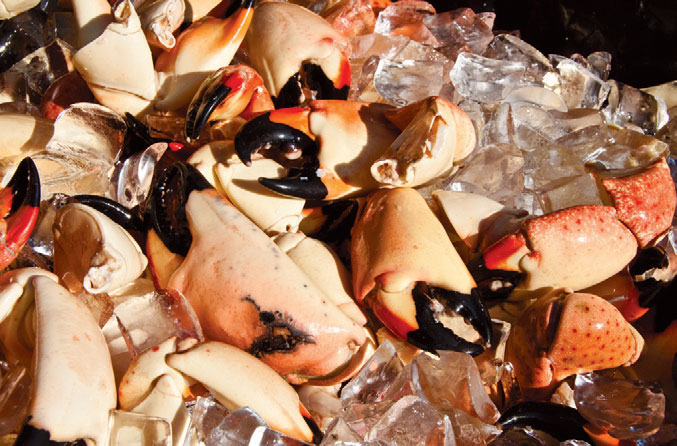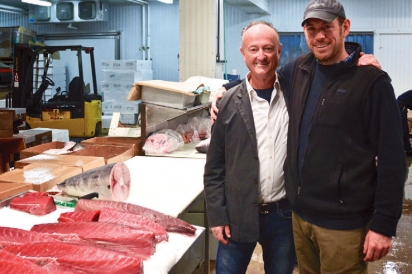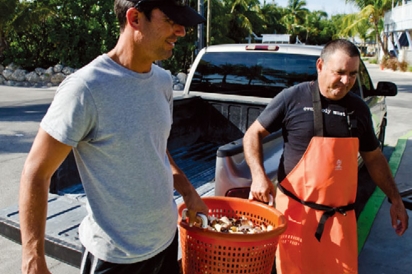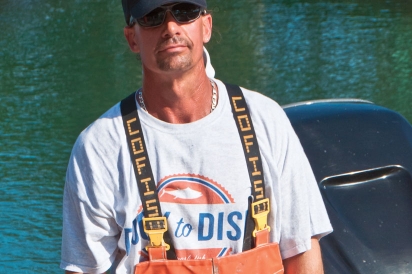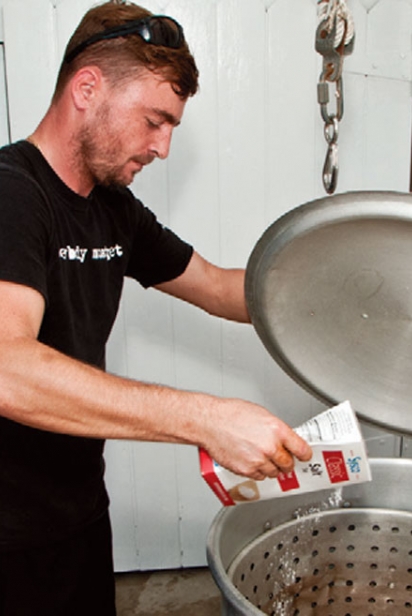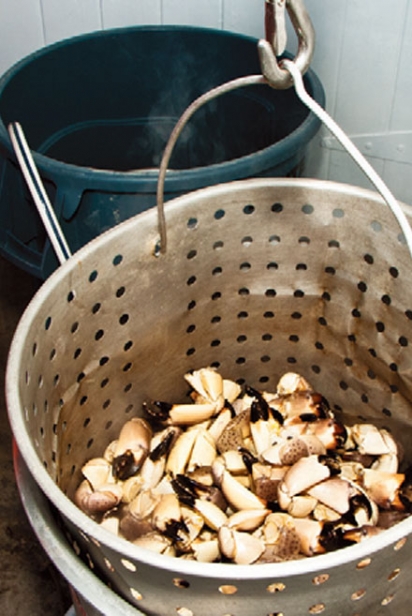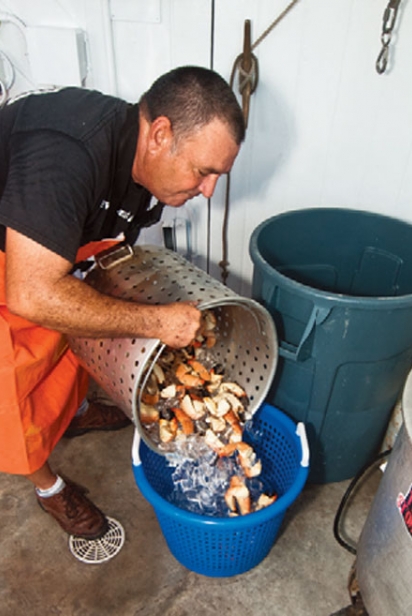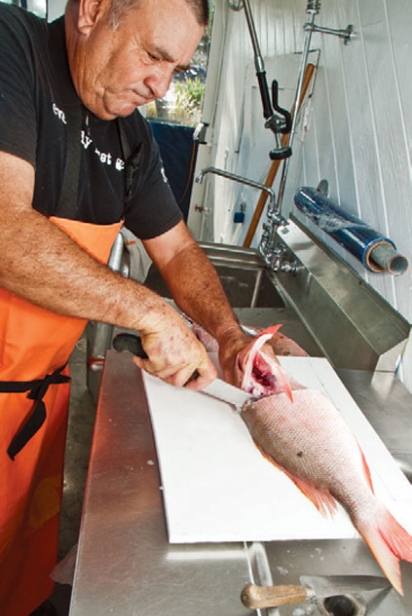Know Your Seafood, Know Your Fisherman, Know Fresh
Community-Supported Fishery Debuts In Key West
The fisherman lands a big cobia in the Gulf and pulls up to the dock in Key West. Immediately, it’s cleaned and filleted, packaged and labeled. A few hours later, it’s on the dinner menu at some of the Keys’ best seafood restaurants. It’s also on the table – grilled, with a squeeze of lime – at a home in Old Town. Fresh? Perfectly. Delicious. Convenient.
So why is everyone eating frozen tilapia from farms in China?
Ninety percent of the seafood we eat in the United States is imported from overseas. Yet one third of the seafood that’s caught here is shipped to other countries. It’s an issue that gets Chris Holland angry.
“We’ve got the best quality seafood in waters around the Florida Keys,” he says. “This is the healthiest source of protein in the world, but we’re giving it all away. America is sending the best seafood overseas and importing the worst.”
Holland, owner of the Ibis Bay Waterfront Resort in Key West, knows well the value of Florida seafood – it’s the star of his resort’s restaurant, The Stoned Crab. But he believes that until people understand why they should be eating local seafood, “we’re just another fish shop.” He understands it will take a major educational campaign to enlighten consumers so that they insist on local seafood for their dinner tables, and a collective effort of restaurants to commit to selling local fish.
Those who know Holland say he’s just the person to lead the Keys initiative to make clean, safe American seafood available to our community. In American Catch: The Fight for Our Local Seafood, Paul Greenberg believes Americans must not only eat local seafood, but set a new course that makes seafood a key part of the health of individuals and our nation. In the book, Holland, a vocal proponent of the health benefits of fresh seafood, discovered a program to get seafood to consumers in the most direct way possible: Dock to Dish, the first community-supported fishery (CSF) program in New York, founded by fisherman and restaurateur Sean Barrett. Like a community-supported agriculture (CSA), in which members pay in advance for getting a share of a farm’s bounty over the season, the CSF provides members with weekly shares of fresh seafood, supporting the fishing community at the same time. It uses a very simple formula, Barrett says: “On the dock side of the equation was an alliance of trusted local fishermen who were eager make the program succeed, and on the dish side was core group of founding members in Montauk who were entirely on board with our mission and goals.” Dock to Dish, launched in 2013, was a success, he says. Everyone was thrilled with the fresh, healthful, local, sustainable seafood.
Then Dan Barber caught wind of Dock to Dish. The noted chef of Blue Hill in Manhattan and author of The Third Plate “immediately embraced our philosophy,” says Barrett. “Dan began celebrating the freshness and flavors of same-day-sourced Montauk seafood with his dining guests, while simultaneously educating us to his concept of true ‘Third Plate’ sustainability. Next he brought a crew of his chef friends on board, who happened to be some of the best in the world, like Eric Ripert, April Bloomfield and Bill Telepan.”
From that meeting, the country’s first restaurantsupported fishery was born. It didn’t take much convincing for the chefs, says Barber. “One taste of the fish and that was all.”
Suddenly, thousands of people were being served Dock-to-Dish fish every week in the top restaurants in Manhattan, Barrett says. Barber’s restaurant guests were enthusiastic – “I think that has a lot to do with Sean, who connects with the staff and brings stories about the catch” – and he found the program compatible with his own definition of ethical and sustainable eating. “It’s another way to expand on a very simple idea: let nature determine the menu. We really need a new paradigm for how we eat, and a model that’s based on having nature lead is a good place to start,” he says.
When Holland read about Dock to Dish, he contacted Barrett. “Chris and his team came up to visit us in Montauk and we knew these guys were on the exact same page as we were, and then they brought us down to visit Key West, where we instantly understood why they had been driven to make a lasting change to the seafood marketplace,” says Barrett. “Chris had already been working hard in Key West on solving the same problems which originally drove us to launch Dock to Dish in Montauk … all too often what we saw on the menus and in the grocery stores came far from our local waters.” The program’s first expansion would be in Key West.
To prepare for the Feb. 14 launch, playfully dubbed Get Fresh Day, Holland and partners Tony Osborn and Paul Menta started working with the various seafood communities in the Keys. Because participation is key to create demand and visibility, they got buy-in from the Florida Keys Commercial Fishermen’s Association. Commercial fishermen benefit from participation because “we pay more and we demand more,” says Holland. “We give them containers, thermometers to maintain temperatures” and other tools for maintaining top quality and safety.
Their marketing aims to put a face to the folks who put seafood on the dinner table through a series of baseball” cards showing Keys fishermen. “Fishermen will become the new heroes of the ocean,” says Paul Menta, the Dock to Dish chef whose role is to insure product quality and handling. “We will make a complete program to educate restaurants and their teams so they understand how to handle their product and serve it. The consumer will see videos of the product at sea, meet the fisherman, then the chef and see the handling of the food.” This makes a meal a multisensory experience, says Stacey Mitchell, director of sales for the Florida Keys and Key West tourism council: “Diners will learn about fishermen, the ecosystem, methods used to embrace marine resource sustainability, all while providing an authentic dining experience.”
As home to the largest commercial fishing fleet from Texas to North Carolina, the Keys is a logical choice to build a solid foundation for Dock to Dish in Florida, where Barrett sees growth potential. “There’s a tremendous amount of pent-up demand for what the Dock to Dish program offers,” he says. “Chris and I would be happy to speak with anyone who would like to join us on our mission and help the program expand elsewhere in Florida.” Adds Dan Barber: “I see this inspiring a lot of different Dock to Dishes – and they will look different depending on where they’re located, but the premise will be the same.”
In the meantime, all eyes are on Key West to lead the way and connect consumers with healthy, delicious American seafood.
HOW DOCK TO DISH WORKS
HOW IT WORKS
Dock to Dish fishermen bring their fish and seafood to Sugarloaf Key. While Rodriguez sorts the claws by size, a pot containing the dock at The Stoned Crab in Key West. Below, fisherman Javier Herrera the dock at The Stoned Crab in Key West. Below, fisherman Javier Herrera and Luis Rodriguez, head of processing, unload stone crab claws caught off dropped into the boil for about eight minutes, then get plunged into ice.
CSF FOR CONSUMERS
Members get a weekly share of fresh, in-season filets and shellfish: lobster, shrimp, stone crabs, yellowtail, cobia, grouper and tuna, for example. “Say you want two pounds of seafood every week. Once you subscribe, you get an email on what's coming in," says Holland. “You come to the fishery [located next to The Stoned Crab] and pick up your box." You can buy insulated dock-to-dish bags and get gel packs to keep the seafood cold. There will also be a hybrid model for walk-ins, and prepared food (lobster stuffed with crab, for example) will also be available. All seafood is guaranteed to be no more than 24 hours old from the time it reaches the dock.
RSF FOR RESTAURANTS
Businesses sign up to receive a certain quantity of whole fish every week. “We rely on what we catch," says Holland. “Chefs we've dealt with love a challenge." Restaurants that participate will be able to brand their seafood menu items as Dock to Dish, just as they might list Certified Angus Beef, for example.
DOCK TO DISH FISH:
• Must be caught by licensed U.S. fishermen
• Must be fresh and never frozen
• Must be monitored under an approved HACCP Plan at all times
• Must be delivered directly from the dock
FIND OUT MORE: Visit docktodish.com.


